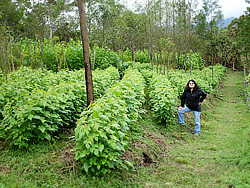
Climate change is already making our planet less inhabitable, with droughts, floods, and severe weather events on the rise. Stabilizing the climate is perhaps the central challenge for humanity in the early decades of this century. Globally, a massive switch to regenerative practices, perennial crops, and regional self-reliance are essential to sequester carbon and reduce emissions. The organic farming and gardening community is already on the forefront of these efforts, but much more is required. Regenerative agriculture is a multipurpose strategy, addressing soil building, regional self-reliance and food sovereignty, perennial farming systems development, climate justice, and productive conservation. As farmers, gardeners, food system organizers, and citizens, it is time for us to reorganize agriculture to address the climate crisis.
Check out video clips below from my keynote address on “Stabilizing the Climate with Perennial and Regenerative Agriculture” at the Northeast Organic Farming Association summer conference August 2011.

And don’t miss the 2012 Carbon Farming Course where speakers including Wes Jackson, Dave Jacke, Elaine Ingham, Darren Doherty, Joel Salatin, and more (including me) will address profitable farm strategies that sequester carbon.
The following article was originally printed in the May 2011 issue of the Permaculture Activist. You can also download the pdf of the original article as it appeared in the Activist: Stabilizing the Climate with “Permanent Agriculture”
Stabilizing the Climate with “Permanent Agriculture”
Trees are one of our most powerful tools to pull carbon from the atmosphere and sequester it in the soil for long-term storage. This is why reforestation and protecting intact forests are such important parts of plans to address climate change. Conventional climate change science tells us that the planet’s capacity for reforestation is limited, however, by the need to preserve land for agriculture
But movements like agroforestry and permaculture show us that farming and trees are not mutually exclusive. From tree crops to contour strips of nitrogen fixing trees between bands of annual crops, there is a wealth of techniques that can give us the best of both worlds. These techniques, should a global effort get behind their implementation on a large scale, could have a major impact on climate change. They also would have numerous other benefits to the planet and its people.
A century ago, writer-farmers like J. Russell Smith coined the term “permanent agriculture” to describe food forestry and other farming practices that combated a key issue of their day – erosion and degradation of farmland. From Smith and his compatriots we in permaculture have taken the name of our movement, though our movement has grown to encompass much more than food forestry. Today these visionary ideas are more essential than ever, to address an environmental crisis on a scale Smith and his contemporaries could not have imagined.
POTENTIAL CLIMATE IMPACT
Trees are fundamentally more efficient than annual crops, with greater net primary productivity. They are larger, leaf out earlier, and start the growing season ready to grow in contrast to annual crops. There is a bigger carbon “pie” to be divided among wood, soil carbon, and food for people than annuals can provide. What can science tell us about the carbon sequestering capacity of permanent agriculture strategies like agroforestry, silvopasture, and food forestry?
Intuitively it makes sense that forest-like agriculture will sequester carbon somewhat like a “real” forest. Broadly speaking this appears to be the case. In their excellent 2004 review of the subject (“Carbon sequestration: An underexploited environmental benefit of agroforestry systems,” in Agroforestry Systems 61:281-295), P.K. Nair and Francesca Montagnini state that generally agroforestry systems sequester somewhat less carbon than forests, though still much more than most annual systems (many of which are net releasers of soil carbon to the atmosphere, and they cause emissions as a result of heavy fossil fuel use). I should note that most agroforestry systems integrate functional trees like nitrogen fixing legumes with annual crops, and proper food forestry with mostly perennial crops could come much closer to the amounts of carbon sequestered in “proper” forests.
The amounts sequestered vary hugely, depending on several variables:
Rainfall: humid climates sequester more than dry ones
Climate: temperate climates sequester more than tropical ones
Species: sequestration varies by species, with some standouts like mesquite
Management: layout and management practices have a huge impact
Design: polycultures sequester more carbon than monocultures in some studies
Allowing for these factors, Nair and Montagnini report estimates of the world carbon storage potential of agroforestry ranging from 9 to 228 tons of carbon/hectare under different circumstances – tremendous variation. They report an estimate of current sequestration by agroforestry at 1 million tons/year. Their document estimates the amount of land that could be converted to agroforestry practices as roughly 585 million to 1.2 billion hectares (the U.S. including Alaska is 770 million hectares). Even at a fairly conservative 25 ton/hectare average, that would sequester 14-20 billion tons – over its lifetime as much as 10% of the total 200 billion tons many experts estimate needs to be removed from the atmosphere even if we stop emissions tomorrow.
Sounds great – but that is a staggering amount of land. It works out to roughly 5-10% of the world’s land (excluding Antarctica), or a whopping 40-80% of currently used arable land.
Permanent agriculture doesn’t just sequester carbon. It is also a fantastic way to restore degraded land to productivity. Much of the carbon we are pulling from the air becomes organic matter, the foundation of productive agricultural soils. The Global Assessment of Human-Induced Soil Degradation (concluded in 1990) found that vast amounts of the planetary surface have been degraded by human activity, through erosion of sloping land, desertification, salinization, and nutrient depletion.
Perennial farming systems are particularly suited to stabilizing slopes and preventing erosion on hillside farms. Roughly 45% of the world’s farmland is classed as sloping at an 8% angle or higher – regeneration of this quantity of farmland with permanent agriculture would sequester 16.8 billion tons of carbon (at 25t/ha).
About 135 million hectares of farmland have an unbelievable 30% slope or greater. I have seen miles of corn growing on mountainsides far steeper than this in Guatemala. These lands are severely eroding and completely unsuitable for annual crops without extensive terracing, living contour hedgerows, or (preferably) replacement with tree crops. If a targeted international project began just focusing on these most vulnerable agricultural areas, 9% of total world farmland, we could (at 25 t/ha, towards the low end of agroforestry’s potential) still sequester 3.3 billion tons of carbon – equal to a third of all human-caused carbon emissions released annually.
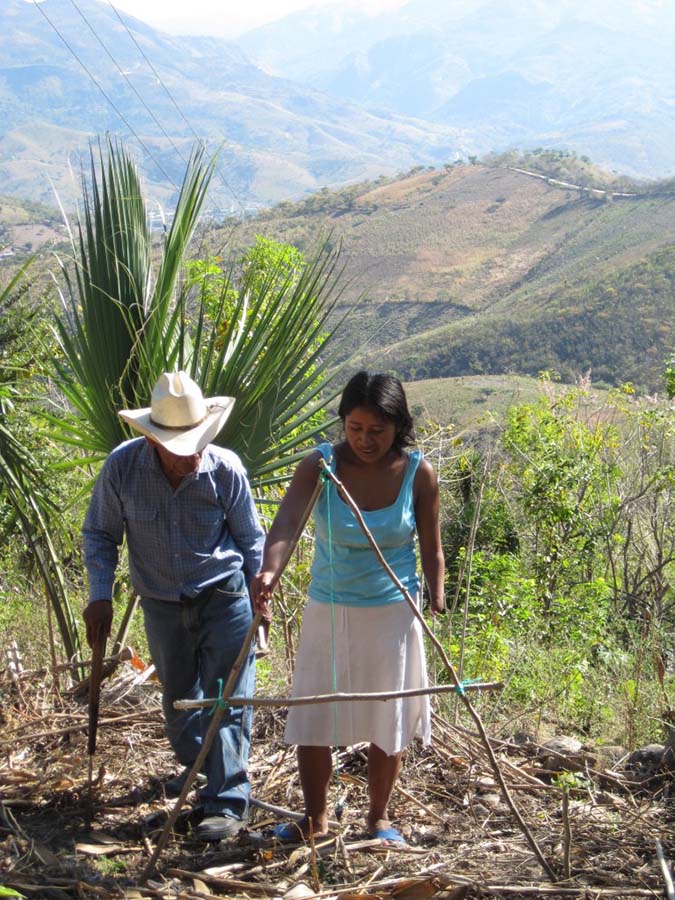
PHOTO: Don Victoriano and Doña Corina of the community of El Matasano in Chiquimula, Guatemala using an A-frame level to mark contours for living terraces. In the background are steep mountainsides covered in cornfields. Photo courtesy Ripple of Hope.
Of course perennial agriculture is only one element to incorporate in a larger effort to slow global warming. Reducing fossil fuel use, converting to clean energy sources, and reevaluating everything from transportation to economic policy are all necessary. But the carbon-sequestering capacity of food forestry and allied systems could and should be a major component of humanity’s efforts to prevent runaway climate change.
So what exactly are the practices that have such great potential to stabilize the climate? The elements of perennial farming systems include perennial crop systems, perennial-annual integration strategies like agroforestry, and livestock-perennial combinations.
PERENNIAL FARMING SYSTEMS
This suite of practices, which I am collectively calling perennial farming systems, represents some of the best of today’s “permanent agriculture” practices. These strategies improve the productive capacity of the soil over time, leading us to call them “regenerative agriculture.” While permaculture did not invent these practices, we have worked hard to integrate, refine, and adopt them around the world.
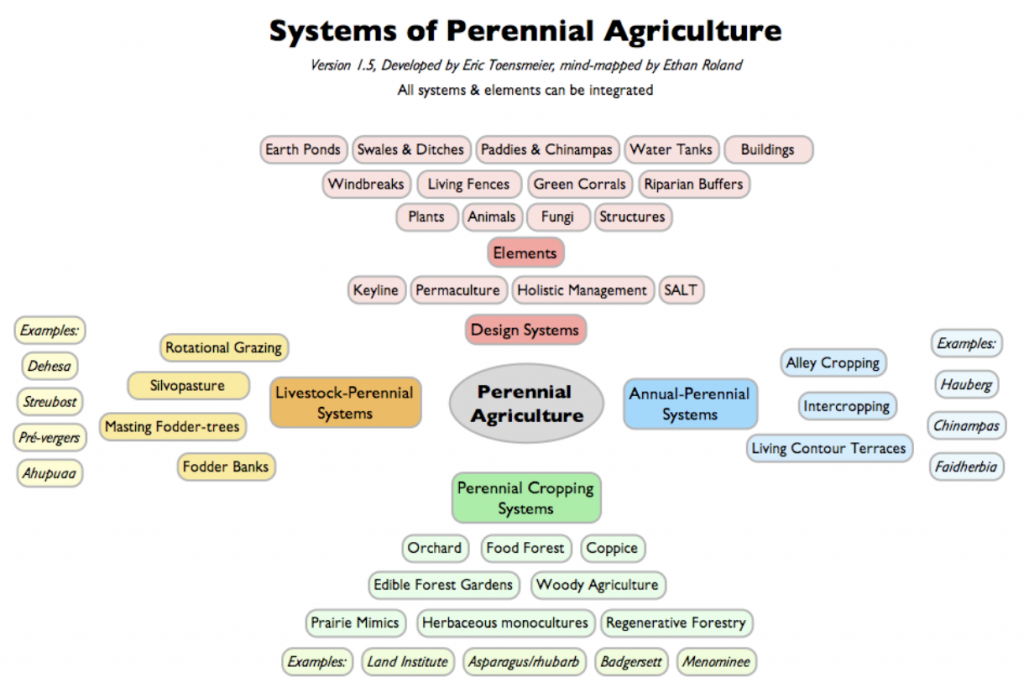
Perennial Crops
The first major category of carbon-sequestering permanent agriculture is perennial crop systems. These crops offer multiple benefits: once established they are no-till, require minimal fossil fuel inputs, and offer long-lived productivity. Systems using these crops include traditional orchards, multi-layer food forests and forest gardens, and herbaceous perennial farming from asparagus and globe artichokes to perennial grain polycultures. While some perennial fruit and nut crops are well known, perennial vegetables are still a fairly new concept for much of the world, and perennial staple crops providing our daily carbohydrates and protein are sadly a rarity. I have been researching the many fascinating perennial staple crops of the world and am preparing an article on them for the fall Permaculture Activist. Though getting people to adopt new foods can be challenging, these crops allow us to eat directly from carbon-sequestering plants.
Mesquite trees are a fascinating example. These nitrogen-fixing trees are highly drought-resistant, with roots a remarkable 450 feet deep. Mesquite pods are edible and nutritionally comparable to wheat. However, mesquite trees can produce as much or more food per acre than wheat or other annual staple crops. Mesquite species are native to arid regions of Africa, Asia, and the Americas, and are under development as a new perennial staple crop. They can sequester up to eight tons of carbon per hectare annually on good soils as a monoculture. Though they are most productive with decent rainfall, mesquites can crop on as little as 4” of rainfall annually! Check out Desert Harvesters’ brand new Eat Mesquite!, a fantastic cookbook with lots of information about this important but neglected crop.
Other Perennial Crops
Perennials provide much more than food. Most material human needs can be met by some form of perennial plant. Fuels are a great example, from coppiced nitrogen fixing firewood to castor oil biodiesel and milkweed gasoline. Timber and construction materials are a major perennial product, with bamboos as a standout plant family providing long-term harvests in perennial systems. Other products include plastics, fibers, herbicides, medicines, mushroom substrates, crafts, and on and on.
Perennial Crop Polycultures
Of course we are not advocating massive monocultures of any of these perennial crops. Vast corporate oil palm monocultures are a perfect example of what can go wrong when promising ideas like perennial crops and biofuels are filtered through the corporate mindset. Rainforests on carbon-banking peat soils are being cleared for oil palm plantations on a massive scale, in the name of “green” biofuels, at a net loss of carbon to the atmosphere. That’s not the win-win we are looking for.
The best examples of perennial crop systems include progressive practices like intercropping, multistoried production with shade crops below a productive canopy, and incorporation of robust nitrogen-fixing components. There are fine examples of these elegant farming systems to be found around the world, I hope to profile some in future articles for the Permaculture Activist.
Perennial-Annual Integration
There are many working models for combining annual and perennial elements. Most involve alternating annual and perennial strips on contour or keyline, with the perennial elements primarily serving functions of slope stabilization and coppiced nitrogen fixation. Sample systems include alley cropping and contour hedgerows. Annuals in these systems can also provide some foods we are more accustomed to, and high-protein crops like beans that can be difficult to provide perennially in most climates.
Annuals can also provide yields while waiting for trees to mature in establishing perennial systems. A final example for use in mixed terrain is production of perennials on slopes with complementary production of annuals on flat land.
My current favorite example of annual-perennial integration is “evergreen agriculture.” This system is a refinement of long-lived indigenous agroforestry practices in semi-arid regions of Africa. Well-mulched annual crops like grains and beans are grown under widely-spaced apple ring acacia trees (Faidherbia albida). The trees fix nitrogen and stabilize soil, with the unique characteristic that they leaf out in the dry season (when crops are not grown below) and drop their leaves to provide sun for productive annual understory crops in the rainy season.
Livestock-perennial integration
Livestock help solve many problems in perennial farming systems. For one, they are much more willing to try new perennial food plants than humans, and convert them into already familiar foods like meat, milk, and eggs. They also circumvent the allergy concerns of some tree nut protein sources. Properly integrated, they can provide benefits and reduce management labor. These contributions include soil fertility, pest control, harvesting, mowing, weeding, and site preparation. Particularly at larger scales of operation, livestock become a substitute for labor and fossil fuel-powered machinery.
Rotational grazing on pasture is a well-developed perennial farming system. Pasture is a perennial polyculture and a remarkable carbon sequestering practice when managed intensively. High yields and soil improvement go hand-in-hand. Though this article is primarily about food forestry, it is worth noting that rotational grazing is also a fine sequesterer of carbon. Imagine the impact if the U.S. took all the land we use to grow annual grain for confinement livestock feed and converted it to rotationally grazed pasture.
Fodder banks are another strategy, useful on small scales and becoming popular in the tropics. These simple coppiced plantings of woody leaf crops are cut and carried to livestock in paddocks or pens. They enable more efficient use of space, collection of manure, and prevention of livestock damage to crops, particularly vulnerable establishing trees.
Silvopasture is the grazing of livestock under trees, typically timber trees, to provide a yield while waiting for timber yields. This practice can be used under many kinds of trees, and can range from cattle under coconuts (common in the Pacific) to weeder geese under complex food forests. Silvopasture is one of the few agroforestry practices being implemented on a commercial scale in the U.S., particularly in the Southeast.
Masting fodder trees are a fascinating but underdeveloped livestock system. This model, as popularized by J. Russell Smith in Tree Crops: A Permanent Agriculture back in 1927, involves trees on pasture as in silvopasture. The difference is the trees produce crops of seeds, pods, fruits, or nuts, which are dropped into the pasture and consumed as fodder by livestock. These systems are very productive and include long-established models like the Portuguese cork-pork dehesa forests – still active today and getting a high premium for acorn-fed pork.
It should be added that ruminant livestock (including sheep, cattle, and goats) produce methane, a potent greenhouse gas. It appears that as part of smart management (such as rotational grazing), the carbon they can help agroecosystems sequester outweighs their methane output. This factor is increased when we consider the fossil fuel-powered machinery they can substitute for, for example in replacing mowed tree crop understory with rotationally grazed pasture.
Fully integrated systems
All these systems can of course be combined, and perhaps are at their best when combined strategically to meet human needs. Permaculture design (and other design systems) can unify productive elements with supporting practices like living fences, green corrals, windbreaks, rainwater harvesting, aquaculture, and green structures. Permaculture farmers like Jerome Osentowski, Sepp Holtzer, and Darrel Frey have shown us some examples of what this looks like in cold climates.
Badgersett “Woody Agriculture”
Phil Rutter of Badgersett Research Corporation (formerly Badgersett Research Farm) began investigating perennial farming systems for carbon sequestration in the early 1980s. He developed a vision of woody agriculture, defined as “the intensive production of agricultural staple commodities from highly domesticated woody perennial plants.” Badgersett’s work in the last three decades has focused on developing “neohybrid” hazel and chestnut strains, for production in coppiced systems on 5-10 year rotations. Rutter envisions hazel and chestnut replacing corn and soybeans, transforming Iowa into a vast food forest.
The Badgersett model is fascinating, and, while still under development, offers tremendous promise. Their ingenious breeding work has resulted in chestnuts with nine nuts per burr instead of the usual three. Their nursery has supplied a network of growers with hundreds of acres coming into production.
Badgersett is also investigating incorporation of livestock into their systems to clean up drops, control pests, and keep the grass mowed between tree rows. Their tree breeding selects for comprehensive pest and disease resistance. Thanks to their groundbreaking work we are decades closer to permanent agriculture for cold climates.
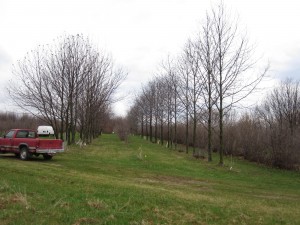
PHOTO: Carbon-sequestering permanent agriculture: experimental rows at Badgersett with (from left) neohybrid chestnut, hazel, hickory (with pawpaw seedlings in tree tubes below), and more neohybrid hazel.
A MULTIFUNCTIONAL STRATEGY
Unlike expensive geoengineering approaches to slowing climate change, regenerative perennial agriculture is remarkable in addressing many of the challenges facing humanity today while sequestering carbon. Were humanity to prioritize this strategy to stabilize our climate, we would reap many other benefits and help address challenges from erosion to food sovereignty.
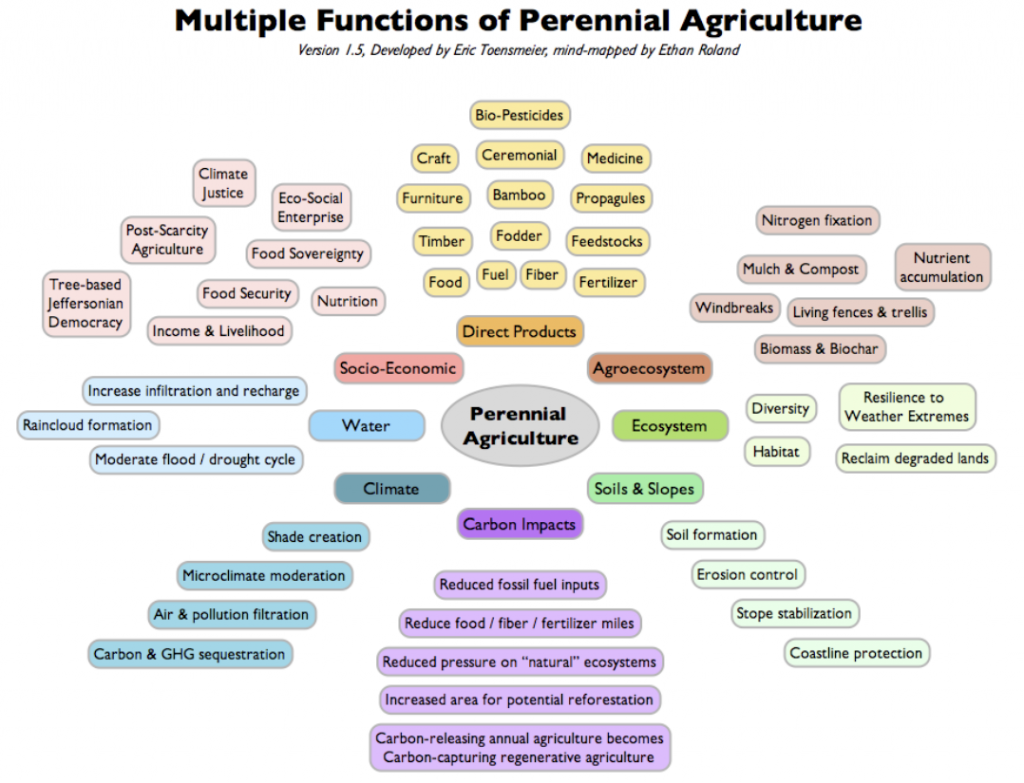
Carbon Impacts
Sequestering carbon is not the only climate impact of permanent agriculture. Perennial agriculture practices require less fossil fuel inputs, both from mechanization and from chemical fertilizers. Implementation of food forestry around the world could reduce fossil fuel use in transport dramatically by increasing local production.
Interestingly, at least in tropical regions, the most powerful climate impact of agroforestry is not in the carbon sequestered on-farm (which is significant), but in the reduction of pressure on wild trees and forests. Because agroforestry provides fuelwood and reduces or eliminates the need for shifting cultivation, every hectare of agroforestry prevents the deforestation of 2.5-10 hectares of wild forest. (Nair & Montagnini 2004).
Improving Soils and Slopes
Perennial farming systems have dramatic powers to stabilize eroding farmland, especially sloping lands. Practices like using nitrogen fixing perennials, keyline plowing, and intenstive livestock rotation have fantastic soil building abilities. Plantings of useful trees can protect coastlines from damage caused by increased storm activity.
Benefits to Water
On the farm scale, trees and perennials can dramatically improve rainwater infiltration and groundwater recharge. At both the farm and regional scale, permanent agriculture can break the flood-drought cycle by soaking up and slowly releasing water like a sponge, providing a longer season of moderate water flow in streams and rivers downstream. Erosion control and slope stabilization means less siltation and nutrient runoff in streams, having effects from local waters to offshore coral reefs. Finally, at the regional scale large plantings of trees transpire sufficient water to create rainclouds, allowing rain to fall further inland and fight drought and desertification.
Ecosystem Benefits
Food forests provide many of the same ecosystem services that “natural” forests do. In addition to the water, soil, and climate benefits mentioned above, they can serve as critical habitat for many kinds of life, and their diversity is much higher than annual agriculture. Regenerative practices can heal degraded land and bring it back to biological productivity and health.
Perhaps most interesting is that permanent agriculture not only fights climate change, but it is also resilient in the face of the increased intensity and frequency of droughts, floods, and other extreme weather events. Trees and perennials typically have stronger and deeper root systems than annuals and can survive and continue to yield in conditions that would ruin many annual crops. Polycultures provide a form of insurance against crop failure due to pests, disease, or weather by having multiple backups of additional crops, so that each year there is always a yield of one kind or another.
Microclimate Impacts
On the farm scale, shade can be essential for livestock and certain crops, particularly in the tropics. We owe coffee, vanilla, chocolate, ginseng, wasabi, ramps, and many other important products to the shady canopies they grow beneath. Trees in particular are also important for filtering air pollution and particulates, and help create a protected and nourishing microclimate in most places they are planted.
Improving Agroecosystem Productivity
Many perennial farming practices are already in common use due to their positive effect on yields. In many parts of the world windbreaks, living fences, and living trellises are standard farming practices. Agroforestry frequently incorporates nitrogen fixing plants, and growing plants for compost and mulching purposes is common in many sustainable agricultural systems. But all of these practices could be much more widely spread.
Biochar, a farm-made charcoal soil amendment, is a practice with tremendous carbon sequestering potential and a great soil builder. It is currently controversial due to concern over its being used as a large scale monoculture and taking land away from food production in the developing world, much as has happened with corn-based biofuels. It appears to me that as an integrated farm practice, not as a vast monoculture, biochar can have a positive effect on farm productivity while sequestering substantial carbon without impacting food security. Any of these perennial farming systems, if practiced by large corporations in vast plantations, can lose carbon efficiency as well as potentially causing negative social and ecological impacts.
A Vast Array of Products
Permanent agriculture can produce most of our material needs. Foods, biofuels, construction materials, fiber products, plant-based plastics, medicine, ceremonial plants, and more can all be produced. Some perennials can continue to yield for hundreds of years once established.
Socio-Economic Benefits
The human benefits of regenerative agriculture are another reason it is so much more desirable than geoengineering projects like pumping sulfur into the atmosphere or liquidized carbon back into empty oil wells. A global investment in perennial farming systems addresses climate justice by sending funds from the developed countries who have caused most of global warming to the developing countries who did the least to cause it but are, perversely, most effected by it. This body of practices can also address food security, particularly by providing resilient crops that can survive droughts and extreme weather events.
Beyond nutrition, transforming degraded land to tree-based farming provides income and regenerative enterprise opportunities to rural people, and could help drive a return to the land for rural people who moved to cities in search of income. Permaculture works best with large numbers of people on small parcels of land, and some research seems to indicate that carbon sequestration is actually higher on small, intensively managed parcels. Thus rural economic revitalization may be another impact of regenerative carbon-sequestering agriculture.
Fossil fuels used in transportation of agricultural goods today are a major source of global warming pollution, so fighting climate change means relocalization of agriculture on a massive scale, whether perennial crops are grown or not. Food sovereignty takes the notions of local food and food security and unites them with broader human rights concerns. The food sovereignty platform includes the right to food and land to grow it on, regional self-sufficiency, prioritizing nutrition and natural resources over international trade, and peaceful democratic control rather than corporate dominance of the food system. Broadscale implementation of perennial farming systems would support food sovereignty by providing a regenerative farming toolkit for community self-determination. A permanent agriculture movement can serve as an ally to food sovereignty against the multinational interests whose drive for short-terms profit is the cause of so many social and ecological problems. I also see permanent agriculture as greatly supporting the development of communities of prosperous smallholders around the world. I like to call this key element of perennial food sovereignty “tree-based Jeffersonian democracy.”
Once established, perennial farming systems require less labor and inputs than annual agriculture. In this light, food forests can be a tool for movements for democracy, nutrition, and human rights. Steering climate change funds and efforts in the direction of regenerative, permanent agriculture can thus help improve the quality of life of people around the world.
STEPPING UP
Obviously converting land use on such a scale would be a massive undertaking perhaps unprecedented in history. It would also have to take place on an extremely tight timeline as well – probably a few decades at most. But addressing climate change requires us to rethink every aspect of our civilization, and agriculture is no exception.
Food forestry has always been a great idea, but in this time of climate crisis it has become an essential one. For many years permaculturists have focused on our own backyards and farms. While that has been critical for developing our ideas, its carbon sequestration impact is barely noticeable on the global scale. Permanent agriculture needs to be spread much, much more widely to have a significant impact. To prevent runaway climate change we need to change our civilization’s infrastructure – and we need to be engaged in our food systems to make that transformation happen.
My emphasis on perennial farming systems is not to discount the many other important contributions that permaculture has made and can make to address climate change. Everything we do, and everything that the transition and climate change movements are doing, is critical to finding a solution. No single strategy is sufficient to do what is required. But large scale conversion of degraded land to regenerative perennial agriculture is a project that we can put forward to the broader climate change movements, and get the world’s resources behind. What a great way for the world to get to know us better – through this strategy that so beautifully expresses our ethics and principles.
We need as well to be honest about what is and isn’t known about permanent agriculture, particularly in cold climates. Let’s target more of our experimentation on replicable models that can be applied at farm-scale in our own regions and beyond. And what better way to demonstrate permanent agriculture than developing regenerative enterprises that allow us to prosper while charting a new course for agriculture.
It seems to me that this is a critical moment in history for permaculture. Terraforming the planet into a perennial food-producing paradise may be the only way to avert climate disaster. Let’s step up as a movement and show the world what we have to offer. Eric Toensmeier is the author of Perennial Vegetables and co-author with Dave Jacke of Edible Forest Gardens. His writing and teaching is currently largely focused on regenerative agriculture for climate stabilization. His writings, videos, and upcoming workshop schedule can be viewed at www.perennialsolutions.org. Eric will address commercial scale food forestry and other regenerative farming practices as part of the upcoming Carbon Farming course in 2012: http://carbonfarming.wordpress.com.
Thanks to Craig Hepworth and Ethan Roland for their help in developing this article.




No comments:
Post a Comment